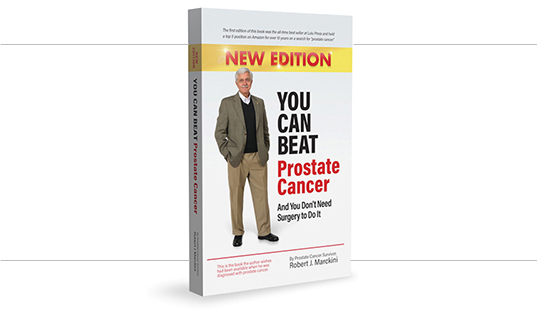
Dear Members (a note from Bob Marckini):
When I sat down to write this opening letter, the first thing that came to mind was how things have changed since we first posted a newsletter in January 2001. When I was diagnosed and treated for prostate cancer almost 24 years ago, I could never have imagined the changes and advances that would be made in the coming years.
Starting with a single hospital-based proton center at Loma Linda University Health (LLUH) in Southern California, the number of medical centers treating prostate cancer patients with proton therapy has grown to nearly 50 in the U.S. and over 100 worldwide. And through the years, we’ve witnessed significant advancements in prostate cancer imaging technology, allowing doctors to accurately identify clinically significant lesions and decide whether they should be biopsied, treated, or monitored through active surveillance.
MRI and PET/CT imaging have made incredible strides. Tumors that were once undetectable can now be found throughout the body, and many of these can be targeted with revolutionary treatments like theranostics, CAR T-cell therapy, and boron neutron capture therapy. Even some metastatic cancers, once thought to be fatal, are being treated with curative intent in many cases. We’ll share more about these cutting-edge technologies in future BOB Tales newsletters.
It's truly remarkable that what began as six patients wanting to stay in touch after proton therapy treatment in December 2000 has grown into an international prostate cancer support group with more than 10,000 members across all 50 states and 39 countries. And on a personal note, persuading my daughter to leave her graphic design and marketing career to work beside me on this “ministry” has been a joy and a tremendous relief in managing the mountain of work this effort has created.
A lot has happened in the past 24 years, and the pace of change and improvement in diagnostics and treatment technologies is accelerating.
In this special two-month summer edition of the BOB Tales, we’re excited to bring you insights on dietary information relevant to those diagnosed with prostate cancer, a surprising development in a potential at-home test for prostate cancer, the extraordinary role AI is beginning to play in the diagnosis and treatment of prostate cancer, and much more.
We welcome any suggestions you have on improving the value of the BOB Tales to our members. Please send your feedback to [email protected].
Bob Marckini
*To print the BOB Tales newsletter or view the newsletter with a larger font size, click here for the PDF file.

- New Study Shows Plant-based Diet May Significantly Slow Prostate Cancer Progression
- At-home Prostate Cancer Saliva Test ‘Better than Blood’ Test?
- The Role of AI in the Diagnosis & Treatment of Prostate Cancer
- AI Reveals Prostate Cancer is Not Just One Disease
- Organic Foods… Worth the Price?
- LLUH Developing Four New Cancer Treatments
- The Surprising Impact of Peanut Butter on Your Prostate
- 5 Benefits of Taking the Stairs

New Study Shows Plant-based Diet May Significantly Slow Prostate Cancer Progression
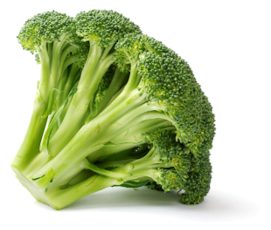
Results from a new study show that eating a diet consisting of mostly fresh fruits, vegetables, and grains can significantly lower the chances of prostate cancer spreading. This link was particularly strong in men who increased their intake of plant-based foods after diagnosis, showing a nearly 50 percent lower risk of their cancer growing compared to those who consumed the most animal products.
Consuming a primarily plant-based diet is also associated with numerous other health benefits, including a reduction in diabetes, cardiovascular disease, and overall mortality. “Making small changes in one’s diet to eat more plant-based foods and less animal-based food each day is beneficial — and the more [plants] you eat, the better,” says lead author Vivian Liu, clinical researcher with the department of epidemiology and biostatistics at the University of California San Francisco.
Study Details
The study involved more than 2,000 men – 65 years old on average – with a diagnosis of localized prostate cancer. Participants each completed a comprehensive diet and lifestyle questionnaire.
Over a span of 6.5 years, 190 participants experienced a progression of their cancer, and 61 died from prostate cancer-specific causes. Through their analysis, Liu and her team found that men who ate the most plant-based foods had a 47 percent reduced risk of their prostate cancer advancing, in comparison to those who consumed the least amount of plant-based foods.
Small Changes Matter
While most prostate cancers are diagnosed in men aged 65 and older, Liu emphasizes that dietary changes can still make a difference in this older population.
“It’s not too late,” Liu says. “You don’t have to make a 180-degree change to your diet. Just focus on small changes to eat more plant-based foods and less animal-based food each day. Greater consumption of plant-based food after a prostate cancer diagnosis has also recently been associated with better quality of life, including sexual function, urinary function, and vitality — so it’s a win on many levels.”
At-home Prostate Cancer Saliva Test 'Better than Blood' Test?
Scientists have developed an at-home saliva test for prostate cancer that could revolutionize early detection. The test uses genetic risk scores derived from saliva samples to predict the likelihood of developing prostate cancer.
The study, involving over 2,000 men, revealed that those in the top 10 percent risk category identified by the saliva test were more accurately diagnosed with prostate cancer compared to traditional PSA blood tests. Remarkably, the saliva test detected cancer in 78 percent of men who had normal PSA levels, highlighting its potential to identify cases that might otherwise be missed.
This advancement is significant as it provides a non-invasive, cost-effective method for early detection, which is crucial for successful treatment. Dr. Dan Brewer from the University of East Anglia (Norwich, England) emphasizes this test could lead to more targeted and personalized screening programs, potentially reducing unnecessary biopsies and treatments. Additionally, the test’s simplicity could make it more accessible, encouraging more men to undergo screening and thus catching more cancers at an earlier, more treatable stage.
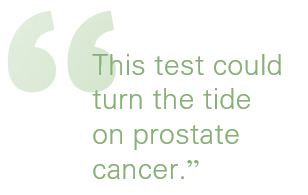
“This test could turn the tide on prostate cancer,” says Brewer. “We have shown that a simple, cheap spit test to identify men at higher risk due to their genetic makeup is an effective tool to catch the cancer early. We can identify men at risk of aggressive cancers who need further tests and spare the men who are at lower risk from unnecessary treatments.”
As this saliva test moves closer to clinical use, it promises to complement existing diagnostic methods, improving the overall landscape of prostate cancer detection and potentially saving lives by facilitating earlier intervention.
The Role of AI in the Diagnosis & Treatment of Prostate Cancer


AI is revolutionizing prostate cancer care across several key areas: diagnostic imaging, outcome prediction, histopathology, and treatment planning. Used synonymously, machine learning (ML) is a subset of AI that involves computers analyzing data and interacting with users without needing explicit programming for every possible scenario. Following, we use the term AI, though it generally encompasses ML concepts.
Diagnostic Imaging
In diagnostic imaging, AI uses advanced machine learning models to analyze MRI scans and identify cancerous lesions, aiding radiologists in making accurate diagnoses. While promising, these tools are supplementary and not replacements for human expertise.
Outcome Prediction
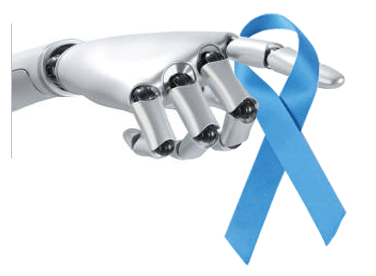
AI’s predictive capabilities extend to prognosis and treatment outcomes by integrating clinical data and genetic information. ML algorithms can predict risks such as cancer progression or response to therapy more accurately than traditional methods. However, widespread clinical adoption hinges on integrating AI seamlessly into electronic medical records and overcoming regulatory challenges.
Histopathology
Histopathology – the study of unhealthy tissues and cells using a microscope – benefits significantly from AI, particularly in automating tasks like Gleason scoring of prostate cancer samples. Tools like Paige Prostate, an AI-based pathology product, use deep learning to assist pathologists in categorizing cancer severity, and enhancing diagnostic accuracy and efficiency.
Treatment Planning
In radiation oncology, AI streamlines treatment planning by automating the labor-intensive process of defining treatment targets and organs at risk. This improves treatment efficiency and accuracy, crucial for techniques like adaptive radiotherapy where treatment plans adapt daily based on patient imaging.
Looking Ahead…
AI’s role in prostate cancer care is poised to expand further. Innovations may include patient-facing AI tools for symptom management and real-time risk assessment during treatment, enhancing personalized care. As AI continues to evolve, its integration into healthcare promises to improve outcomes and efficiency across the spectrum of prostate cancer diagnosis and treatment.
AI Reveals Prostate Cancer is Not Just One Disease
UK researchers led by the University of Oxford and the University of Manchester recently used AI to analyze vast amounts of genetic and clinical data from prostate cancer patients. In doing so, they discovered distinct sub-types of prostate cancer, each with unique biological features. This groundbreaking finding challenges the traditional view that prostate cancer is a single disease. Instead, it reveals it as a spectrum of disorders with unique molecular characteristics.
The study highlights the potential of AI in transforming cancer research and treatment. AI algorithms can analyze complex datasets far more efficiently than traditional methods, revealing patterns and relationships that may not be apparent to human researchers. This capability not only aids in understanding the underlying biology of diseases like prostate cancer, but also paves the way for developing personalized treatment strategies.
The findings from this research could lead to future clinical trials aimed at testing targeted therapies for each sub-type of prostate cancer. Ultimately, the goal is to improve survival rates and quality of life for patients by providing treatments that are not only more effective, but also better tailored to the individual characteristics of their cancer.

We’ve been producing BOB Tales newsletters for 23 years. During this time we’ve published articles that many new members haven’t seen, and some older members may have forgotten. So, we periodically re-run articles from past BOB Tales. This one from September 2007 is titled:
Organic Foods... Worth the Price?
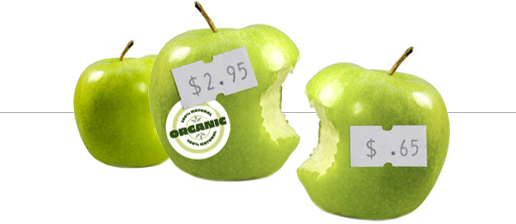
We all know that commercially grown foods have pesticides. Maybe this is one of the reasons organic food has hit the mainstream market, not just the upscale markets, but even your local grocery stores. So the question remains, is it worth the extra price?
Are pesticide levels in foods harmful?
Pesticides are poisons. When given to animals in high doses, they can cause cancer, nervous system damage, and birth defects. Farmers who work with pesticides appear to have higher rates of asthma, Parkinson’s disease, leukemia, myeloma, non-Hodgkin’s lymphoma, and cancers of the lip, stomach, skin, brain, and prostate. The Agricultural Health study found that men who applied pesticides for a living in Iowa had a 41 percent increased risk of prostate cancer, while farmers who applied their own pesticides had a 17 percent increased risk.
Of the 900 active ingredients in the pesticides that can legally be used in the United States, some 20 cause cancer in animals and are classified as possible human carcinogens. Yet there is remarkably little data on the risk to consumers from eating fruits and vegetables that contain pesticide residues. Keep in mind too, there’s a big difference in the amount of pesticide one gets from eating some fruits or vegetables compared to what you get when eating an animal product, such as meat, from animals that ate grain and have concentrated amounts of pesticide residues in their tissues. On the positive side, people who eat more fruits and vegetables (with or without pesticides) have a lower risk of heart disease. They are also less likely to suffer cancers of the colon, mouth, pharynx, esophagus, stomach, and lung, according to the National Cancer Institute.
Do organic foods have fewer pesticides?
The answer is yes. About 75 percent of conventionally grown fruits and vegetables contain tiny amounts of pesticides, and often more than one kind. However, organic produce is just the opposite. One study that examined more than 94,000 samples of 20 crops tested by the USDA, the state of California, and Consumers Union, found that only about one in four organic fruits and vegetables contained a pesticide, and then the amount was usually smaller than what’s found in conventional food. The reason organic produce would have any pesticides is likely due to background contamination and pesticide drift. DDT and dieldrin were banned from agriculture decades ago; still traces persist in the soil and contaminate anything that’s grown in it, organic or conventional. Pesticides can often drift in the wind from nearby conventional farms
Organic – Legal Definitions
Organic fruits and vegetables are grown without synthetic pesticides, synthetic fertilizers, or sewage sludge and haven’t been genetically engineered or irradiated.
Packaged foods:
- “100% Organic” = All ingredients are organic.
- “Organic” = At least 95% of the ingredients are organic.
- “Made with Organic Ingredients” = At least 70% of the ingredients are organic.
Which Fruits and Vegetables are Best?
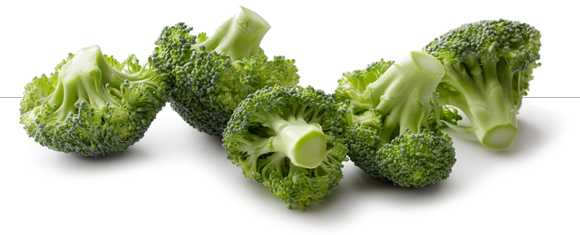
If you want to avoid pesticides, but don’t want to buy everything organic, here’s some information about which organic produce makes the most difference. This was put together by the Washington, D.C.,- based non-profit Environmental Working Group (EWG).
EWG ranked the most commonly used fruits and vegetables using the results of 43,000 analyses of pesticides conducted by the U.S. Department of Agriculture and the Food and Drug Administration from 2002 to 2004. The foods were ranked on the percentage of samples that had detectable pesticides; the percentage of samples that had two or more pesticides; the average number of pesticides found on a sample; the average concentration of all pesticides found; the maximum number of pesticides found on a single sample; and the total number of pesticides found.
The list of 43 fruits and vegetables is too long to list, but here are the two extremes:
- “The Dirty Dozen” were in this order: peaches, apples, sweet bell peppers, celery, nectarines, strawberries, cherries, pears, grapes (imported), spinach, lettuce, potatoes.
- On the very low side, “The Consistently Clean,” from good to very lowest: papaya, broccoli, cabbage, bananas, kiwi, sweet peas (frozen), asparagus, mango, pineapples, sweet corn (frozen), avocado, and onions.
According the EWG, you can lower your pesticide exposure by almost 90 percent if you avoid “The Dirty Dozen” (the twelve most contaminated fruits and vegetables), or buy them organic, and also eat the 12 least contaminated.
This article was based on the July/August 2007 issue of Nutrition Action, published by the Center for Science in the Public Interest.
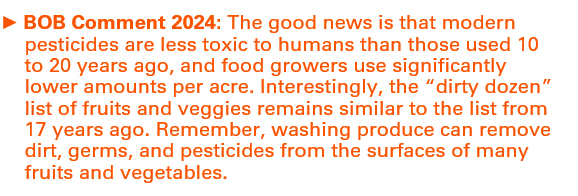
LLUH Developing Four New Cancer Treatments
Loma Linda University Health (LLUH) is pioneering radical new cancer treatment technologies to target aggressive, metastatic prostate cancers and previously incurable cancers. Among the many deadly cancers LLUH is focusing on are glioblastoma and pancreatic cancer, diseases that have claimed the lives of public figures like Ted Kennedy, John McCain, Steve Jobs, and Patrick Swayze, as well as some of our own friends and loved ones.
LLUH’s innovative therapies are already showing extraordinary results. One patient with advanced metastatic prostate cancer, given just weeks to live, is pain-free and thriving three years later, thanks to theranostics. Future BOB Tales newsletters will cover more breakthroughs, with theranostics as well as CAR T-cell therapy, boron-neutron capture therapy (BNCT), and another cutting-edge technology, which is an evolution of a technology LLUH pioneered years ago.
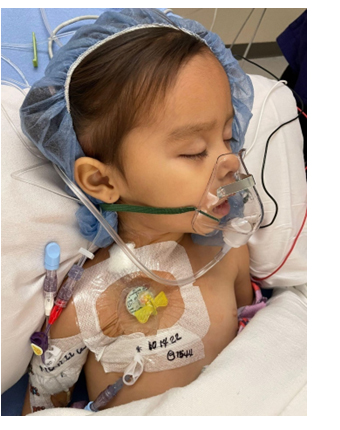
The story of Crystal Quinonez and her daughter, Oakley, illustrates the urgent need for new cancer treatments. In September 2022, Crystal’s vibrant 3-year-old, Oakley, was diagnosed with acute lymphoblastic leukemia (ALL) after initially displaying cold-like symptoms. This diagnosis led to a grueling treatment regimen involving chemotherapy, steroids, and lumbar punctures. Oakley endured lethargy, appetite loss, leg pain, infection risks, mood changes, and hair loss. Losing her hair was particularly heartbreaking for her.
Oakley’s treatment included Blinatumomab, an advanced monoclonal antibody therapy targeting leukemia cells. Unlike conventional chemotherapy, Blinatumomab uses immunotherapy to engage T cells to destroy cancer cells. Though effective, the treatment process is intense and distressing for both children and their parents.
However, there is hope. LLUH’s recent introduction of CAR T-cell therapy offers a transformative approach to cancer treatment. This therapy involves harvesting T cells from the patient, genetically modifying them to target cancer cells, and reinfusing them to attack the cancer. CAR T therapy represents a revolutionary, personalized cancer treatment that could dramatically shorten and simplify the treatment process for ALL and many other cancers. The diagram below illustrates how this technology works.
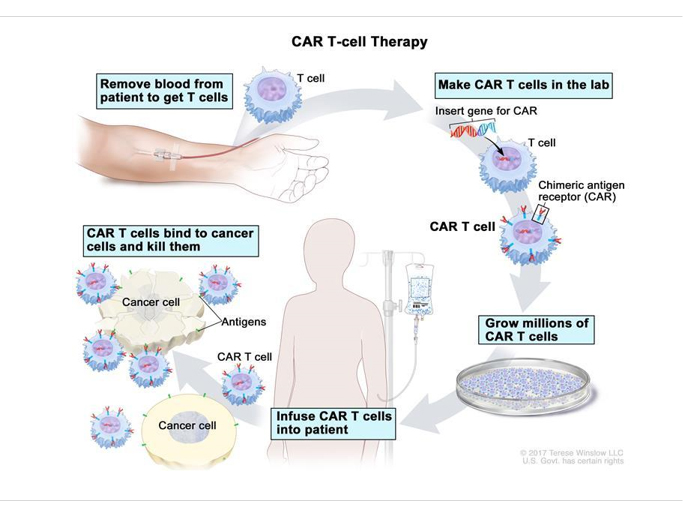
Oakley’s resilience is inspiring. Her hair is growing back, her energy levels are up, and she’s returning to a normal life despite the challenges of her treatment. Her road to recovery has been long and difficult.

The new technologies will help children like Oakley get through treatment much quicker (in many cases just one treatment!), and with considerably less trauma.
We strongly encourage you to watch this video on Oakley's journey. Tip: Have Kleenex handy.

LLUH aims to raise $100 million to expand its treatment and research facilities, vital for advancing these cancer therapies and making them accessible to patients. To support LLUH’s Stronger Together campaign and contribute to these life-saving initiatives, please visit LLUH Stronger Together Campaign. Your support can help ensure these pioneering treatments reach those who need them most.

More Giving Options
-
Online: Donate here. From the pull-down menu, choose where you’d like to direct your gift — 1) Cancer Center Vision; 2) Proton Research through the James M. Slater Chair; 3) Proton Research through the Robert J. Marckini Chair; or 4) Other (specify any area you'd like your gift directed in the space provided)
-
By Check: Make your check out to “LLUCC.” Specify where you’d like to direct your gift in the memo line — 1) Cancer Center Vision; 2) Slater Chair; 3) Marckini Chair; 4) write "unrestricted" so LLUH can use it where it’s needed most. Mail your check to: LLUH, Office of Philanthropy P.O. Box 2000, Loma Linda, CA 92354.
-
By Phone: Call Regina Joseph at 909-558-5010.

The Surprising Impact of Peanut Butter on Your Prostate
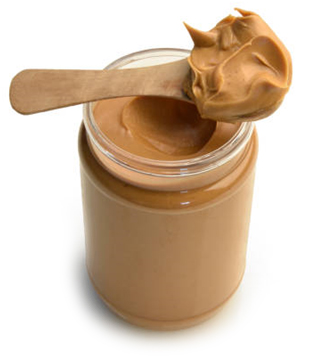
Prostate health is a significant concern for men as they age, with three main conditions to watch out for: prostate cancer, prostatitis, and benign prostatic hyperplasia (BPH). BPH, commonly known as an enlarged prostate, affects most men as they grow older, causing urinary issues due to urethral compression.
Interestingly, a potential ally in managing BPH symptoms could be found in a common staple: peanut butter. This unexpected benefit stems from beta-sitosterol, a plant-based compound known for its cholesterol-lowering properties. While it doesn’t shrink the prostate, beta-sitosterol helps improve bladder emptying and urine flow consistency.
Research highlighted in Nutrition and Cancer found significant levels of beta-sitosterol in peanuts and peanut butter, making the spread an excellent dietary source. However, moderation is key.
Nutrition plays a crucial role in prostate health. Experts recommend a plant-based, high-fiber, low-fat diet to mitigate cancer risks, despite the nutrients peanut butter offers. Importantly, BPH itself isn’t a precursor to prostate cancer, as clarified by WebMD.
Can peanut butter also be bad for your prostate?
According to a study published in 2019 in Prostate Cancer and Prostatic Diseases, consuming peanut butter is linked to a “significantly increased risk” of non-advanced prostate cancer, though not with advanced prostate cancer. Although the study provided no explanation for why this association exists, peanut butter, like other nut-based products, contains a substantial amount of fat. Some studies suggest that high-fat diets may increase the risk of prostate cancer and contribute to its progression.
Ultimately, it’s wise to consult your doctor before making peanut butter (or any food) a daily staple, especially if it’s for your BPH. Balancing dietary choices remains essential for overall prostate health as men age.
5 Benefits of Taking the Stairs
Stair climbing offers a practical way to integrate physical activity into your day. It’s convenient, accessible, and usually free if you have stairs nearby. There are also a variety of health benefits to stair climbing. Five are listed below.
1. Promotes Cardiovascular Health
Regular stair climbing is a highly effective cardiovascular workout that can enhance heart health by increasing your heart rate, improving blood circulation, and reducing the risk of diseases such as stroke, heart attacks, and blood clots. According to research, climbing more than five flights of stairs daily can reduce the risk of cardiovascular diseases by up to 20 percent.
2. Helps Manage Body Weight
Stair climbing is also an excellent way to aid in weight loss and build stamina. It’s a simple aerobic exercise that burns more calories per minute than jogging.
3. Strengthens Muscles and Joints
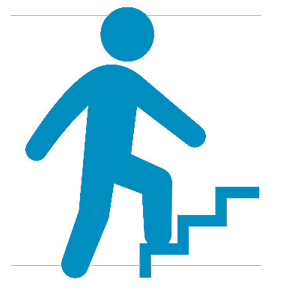
Climbing stairs engages nearly all major muscles, particularly the lower body – calves, hamstrings, quads, and glutes. Regular stair climbing strengthens the legs, improving running ability and activities such as rowing and cycling.
Regularly climbing stairs can also strengthen joints. It stimulates bone metabolism as it involves stretching your muscles and major joints. Stair climbing is an excellent exercise for optimizing bone health. Moving vertically against gravity while climbing stairs exerts pressure on the bones, gradually increasing their strength.
4. Boosts Mood and Well-being
Climbing stairs can help alleviate mood swings, stress, and anxiety by stimulating the release of endorphins which in turn boosts dopamine levels. This process can soothe sore muscles, reduce pain, and enhance feelings of happiness and relaxation. With an improved mood, daily activities become more manageable, productivity increases, and mental health benefits.
5. Improves Balance and Coordination
Research involving older adults has demonstrated that regular stair climbing enhances dynamic balance performance and lower limb muscle strength, contributing to improved overall fitness and reduced risk of falls.
So how many stairs should you climb?
Some studies indicate that climbing five to six flights of stairs per day (equivalent to 50 to 60 total steps) can have a positive impact on your health. In fact, a 2023 study showed a correlation between climbing at least 50 steps daily and a 20 percent lower risk of cardiovascular disease including heart attack, heart failure, and stroke.

You Can Beat Prostate Cancer: And You Don't Need Surgery to Do It - Second Edition
Still Strong in Amazon!
Bob’s book continues to significantly impact people’s lives, as evident by the feedback received on Amazon and by the many daily email messages we receive.
In Amazon, the book is still holding strong in the No. 2 position on a list of more than 6,000 books on prostate cancer. And, the first and second editions have a combined 766 reader reviews, averaging a five-star rating.
Recent Amazon Reviews
Following are a few short reviews from the past few months...

Excellent Read
Very good read on prostate cancer. I read it twice last year – once prior to receiving proton treatment, and again during. It’s a must-read for anyone who has been diagnosed with prostate cancer

So much positive information!
This book was so positive and uplifting when we received the prostate cancer diagnosis. Bob provides a holistic approach to treatment. It really inspired us and eliminated many of our fears. Thank you! We too survived the diagnosis and treatment!

You Can Beat Prostate Cancer
This book opened my eyes after being diagnosed within the last year. A lot to think about…

Very Interesting Book
This book was written about the treatment of prostate cancer with proton radiation therapy (among others). The author’s experience was extremely useful in my pursuit of treatment options.

Was the book helpful to you?
If Bob’s book was helpful to you and you’d like to help others find it on Amazon, please write a review. Every single review contributes to the credibility and visibility of the book.

Last Month's Brain Teaser
What is remarkable about the following question?
One plus twelve = Two plus eleven
Hint: Jeopardy fans should get this one!
Answer:
“One plus twelve” is an anagram of “two plus eleven.” In other words, the same letters that spell “one plus twelve,” can be rearranged to spell “two plus eleven.”
Winner:
The June 2024 brain teaser winner is a BOB member from Harrisburg, NC, who was treated for his prostate cancer in 2012 at University of Florida Health Proton Therapy Institute in Jacksonville, FL.
Congratulations! Your signed copy of Bob’s book is on the way…
Runner Ups...
We had a couple of runner ups last month. Apparently, there was more than one correct answer to the brain teaser! BOB member John Yarborough of Franklin, TN, answered: “One plus twelve = two + eleven is a palindrome: 112211.” Susan Fancher, our long-time friend and spouse of beloved, deceased BOB member, Jack Fancher, answered: “13=13.” Both correct!

New Brain Teaser – An Easy One
The more you take away the bigger it gets; the more you add the smaller it becomes. What is it?
Send your brain teaser answer to [email protected] for a chance to win a signed copy of Bob Marckini’s NEW second edition book, You Can Beat Prostate Cancer.

Senior Wisdom
- Be decisive. Right or wrong, make a decision. The road is paved with flat squirrels who couldn’t make a decision.
- When I get a headache, I take two aspirin and keep away from children, just like the bottle says.
- If you see me talking to myself, just move along. I’m self-employed. We’re having a meeting.
- I hate it when I can’t figure out how to operate the iPad and my tech support guy is asleep. He’s five and it’s past his bedtime.
- I didn’t make it to the gym today. That makes five years in a row.
- “On time” is when you get there.
- Even duct tape can’t fix stupid, but it sure does muffle the sound.
- It would be wonderful if we could put ourselves in the dryer for 10 minutes, then come out wrinkle-free and three sizes smaller.

Real Headlines!
- Man Struck By Lightning Faces Battery Charge: Hmmm…
- Hospitals Are Sued by Seven Foot Doctors: Wow, talk about tall!
- Juvenile Court to Try Shooting Defendant: Well, that’s not right.
- Indian Ocean Talks: It’s a miracle!
- Kicking Baby Considered to Be Healthy: I beg to differ!
- Most Earthquake Damage is Caused by Shaking: Huh…
- Fish Need Water, Feds Say: These agents are smart!
- Attorney Accidentally Sues Himself: Well, that was dumb.
- Sewer Blocked by a Large Pooh: You really can’t make this stuff up!
 Grandparent Scams
Grandparent Scams
Grandparents often find it difficult to say no to their grandchildren, a vulnerability that scammers are exploiting! Using personal information from social media or purchased data, scammers impersonate grandchildren or close relatives in crisis, requesting immediate financial help. They may spoof caller IDs to appear as trusted sources. Imposters often claim to be in an accident or arrested, asking grandparents not to inform parents and sometimes even involve a phony lawyer to demand payment. Advanced AI technology also allows scammers to clone voices using short audio or video clips.
Various forms of this scam exist. Make sure to educate yourself and raise awareness with friends and family. Some tips you may want to pass on are below.
Be Vigilant About Scam Calls
Exercise caution if you receive a phone call and you’re pressured for information or asked to send money quickly. Scammers often coerce victims into transferring money via mobile payment apps, wiring money, or buying gift cards or money orders. Some may even arrange to meet in person to collect the money. If you receive such a call, hang up immediately and report it to local law enforcement.
To reassure yourself, call or text your family members directly to verify their claims or requests.
More Tips to Help You Avoid Being Scammed
Awareness is one of the best defenses against scammers. Check out FCC consumer guides on caller ID spoofing and illegal robocalls. You’ll also find tips and resources for call-blocking apps and services.
Read consumer awareness articles about scams targeting older Americans on the Better Business Bureau website or learn about local scams using the AARP Fraud Watch Network Scam-Tracking Map.
File a Complaint
You can report unwanted calls and spoofing to the FCC. For information on imposter scams and to file a consumer complaint, visit the Federal Trade Commission’s website.

Did You Know...?
- The Spanish national anthem has no words. The “Marcha Real” is one of only four national anthems in the world (along with those of Bosnia, Herzegovina, Kosovo, and San Marino) to have no official lyrics.
- Before we had toilet paper Americans used corn husks. Ouch!
- A blue whale’s heartbeat can be detected up to two miles away. And their hearts weigh almost 400 pounds!
- The Eiffel Tower was supposed to be in Barcelona. When Gustave Eiffel’s design was rejected by the Spanish city for being too ugly, he pitched it to France. The locals weren’t in love with it either, but tourists from around the world flock to Paris to see it!
- The shortest commercial flight in the world is in Scotland. The quick 1.7-mile journey between Westray and Papa Westray islands takes just 90 seconds by plane.
- Wearing a necktie can reduce blood flow to the brain. Too-tight ties have also been found to increase pressure in the eye, possibly leading to an increased risk of glaucoma.
- Bananas are radioactive. Bananas are radioactive because they contain the natural isotope potassium-40, which is a naturally occurring radioactive element.
- You remember more dreams when you sleep badly. Frequent awakenings during the night increase the chances of waking up during or shortly after a dream, making it easier to recall.



A Stranger Makes a Choice: What Would You Do?
It was every subway rider’s nightmare, times two.
Who hasn’t wondered: “What if I fell to the tracks as a train came in? What would I do?” Or “What if someone else fell? Would I jump to the rescue?”
Wesley Autrey, a 50-year-old construction worker and Navy veteran, faced both questions in a flashing instant and got his answers almost as quickly. Mr. Autrey was waiting for the downtown local at 137th Street and Broadway in Manhattan around 12:45 p.m., taking his two daughters, Syshe, 4, and Shuqui, 6, home before work.
Nearby, a man collapsed, convulsing. Mr. Autrey and two women rushed to help. The man, Cameron Hollopeter, 20, got up but then fell to the tracks, between the two rails. The headlights of the No. 1 train appeared. “I had to make a split decision,” Mr. Autrey said. So, he made one, and leapt. Mr. Autrey lay on Mr. Hollopeter, his heart pounding, pressing him down in a space roughly a foot deep. The train’s brakes screeched, but it could not stop in time. Five cars rolled overhead before the train stopped, the cars passing inches from his head, smudging his blue knit cap with grease. Mr. Autrey heard onlookers’ screams. “We’re okay down here!” He yelled. “But I’ve got two daughters up there. Let them know their father’s okay!” He heard cries of wonder and applause.
Power was cut, and workers got them out. Mr. Hollopeter, a student at the New York Film Academy, was taken to St. Luke’s-Roosevelt Hospital Center with only bumps and bruises. The police said it appeared that Mr. Hollopeter had suffered a seizure. Mr. Autrey refused medical help, saying nothing was wrong. He visited Mr. Hollopeter in the hospital before heading to his night shift. “I don’t feel like I did something spectacular; I just saw someone who needed help,” Mr. Autrey said. “I did what I felt was right.”
Low PSAs to all,
Bob Marckini and Deb Hickey
*Click here for the printable PDF version of this newsletter.
NO MEDICAL ADVICE: Material appearing here represents opin1ions offered by non-medically trained laypersons. Comments shown here should NEVER be interpreted as specific medical advice and must be used only as background information when consulting with a qualified medical professional.


